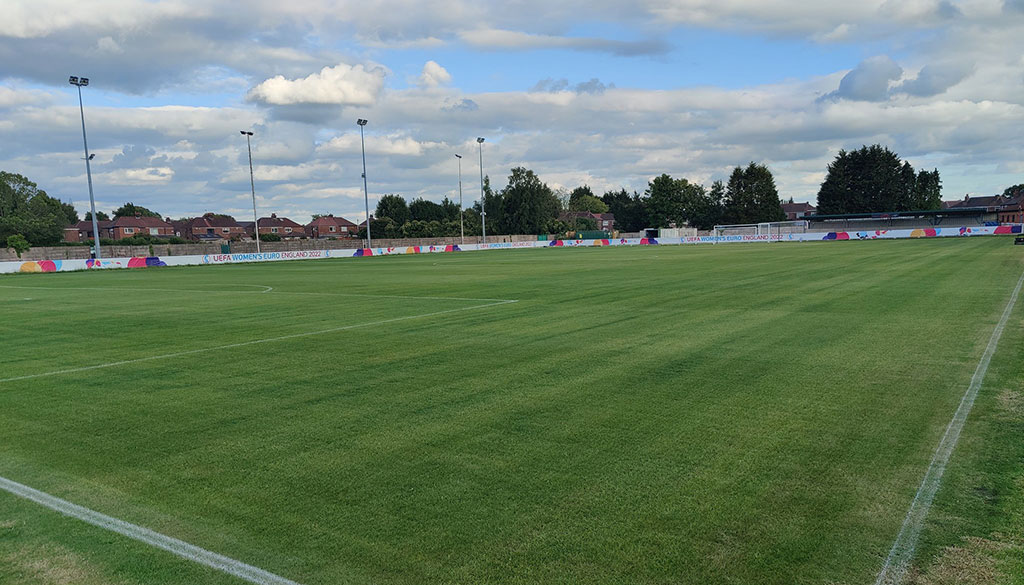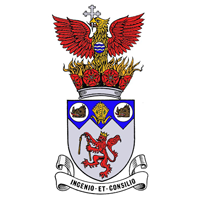
Emblematically Speaking - Irlam
Wed 4th April 2018 | Irlam | By Stewart Taylor
We return to familiar ground in the shape of a town Coat of Arms, as used by Irlam FC as their club emblem.
The following is an extract from the Cadishead and Irlam Guardian, which goes into the sort of detail we crave when looking into the meanings of the various devices on a Coat of Arms.
The design for Irlam's Coat of Arms has been officially adopted by the Urban Council and has been sent to the College of Heralds for approval.
It is the work of Mr. H. Ellis Tomlinson, M.A. Poulton-le-Fylde. The expense of the proceedings is being bourne by the Lancashire Steel Corporation Ltd.
The official description of the coat of arms is:-
The shield describes the manorial history of the ownership of the area.
The lion (red) is that of the de Hultons and Farnworths who held the lands in the 14th Century.
The flail that the lion holds is from the crest of the de Traffords who held the land in the sixteenth Century, and it also reflects the agriculture of the area.
The top part of the shield is the blue indented "chief" of the Lathoms, the principal Irlam family of the 16th, 17th and 18th Centuries. The boar’s heads are from the Bartons and Booths who held the land in the 14th Century. The mitre represents Stanlaw Abbey which held Cadishead from the 13th to the 16th Century.
The crest represents Irlam and Cadishead's recent history. The local industries, especially the Lancashire Steel Corporation, are shown by the crown of Lancashire, red roses and flames above a steel rim. The eagle is from the Greaves family who lived in Irlam Hall in the 19th Century, and blue and white ripples (or "fountain") on the eagle's breast represent the River Irwell, River Mersey and the Manchester Ship Canal which are so important in the growth of the area.
The motto ("Ingenio et Consilio") means "with skill and wisdom" or "by good character and council", and also indicates the initials I and C for Irlam and Cadishead.
We are rather taken by the idea of using a Latin motto in which the initials of the motto are the same as the initials of the Urban District – we just wonder if there are any other examples.
The arms were officially granted on April 12th 1955 and, as we have seen a number of times in this series, contain a wealth of information. The split between the devices on the shield representing the various families who were historically significant in the area and the crest representing more modern times in celebrating local industry is typical of Coat of Arms design of the time.
But this is not the end of the story as the emblem used by Irlam FC, and other organisations associated with the town, is not the full Coat of Arms.
Once granted, the full Coat of Arms was very restricted in its use. Reproduction of the Coat of Arms was prohibited leading to the Urban District Council having to refuse requests from various local organisations to use it.
A solution to this problem was found by designing a Town Badge and the Council encouraging organisations to use that badge. The badge includes most of the Coat of Arms but missing are the side adornments, a helmet and a crown.
Many organisations in the town then adopted this badge as their emblem including the local Rotary Club, a local secondary school and, relevant to our story, the local football club.
So, what might at first appear to be a Coat of Arms is not, contrary to the first line in this article. Nevertheless, the emblem does, as shown above, describe the district very well indeed.
Our thanks to Maurice Cullen of Irlam and Warren Dodd of Irlam FC for their help with this article.
 Emblematically Speaking - Irlam
Emblematically Speaking - Irlam
Wed 4th April 2018 | Irlam
By Stewart Taylor

We return to familiar ground in the shape of a town Coat of Arms, as used by Irlam FC as their club emblem.
The following is an extract from the Cadishead and Irlam Guardian, which goes into the sort of detail we crave when looking into the meanings of the various devices on a Coat of Arms.
The design for Irlam's Coat of Arms has been officially adopted by the Urban Council and has been sent to the College of Heralds for approval.
It is the work of Mr. H. Ellis Tomlinson, M.A. Poulton-le-Fylde. The expense of the proceedings is being bourne by the Lancashire Steel Corporation Ltd.
The official description of the coat of arms is:-
The shield describes the manorial history of the ownership of the area.
The lion (red) is that of the de Hultons and Farnworths who held the lands in the 14th Century.
The flail that the lion holds is from the crest of the de Traffords who held the land in the sixteenth Century, and it also reflects the agriculture of the area.
The top part of the shield is the blue indented "chief" of the Lathoms, the principal Irlam family of the 16th, 17th and 18th Centuries. The boar’s heads are from the Bartons and Booths who held the land in the 14th Century. The mitre represents Stanlaw Abbey which held Cadishead from the 13th to the 16th Century.
The crest represents Irlam and Cadishead's recent history. The local industries, especially the Lancashire Steel Corporation, are shown by the crown of Lancashire, red roses and flames above a steel rim. The eagle is from the Greaves family who lived in Irlam Hall in the 19th Century, and blue and white ripples (or "fountain") on the eagle's breast represent the River Irwell, River Mersey and the Manchester Ship Canal which are so important in the growth of the area.
The motto ("Ingenio et Consilio") means "with skill and wisdom" or "by good character and council", and also indicates the initials I and C for Irlam and Cadishead.
We are rather taken by the idea of using a Latin motto in which the initials of the motto are the same as the initials of the Urban District – we just wonder if there are any other examples.
The arms were officially granted on April 12th 1955 and, as we have seen a number of times in this series, contain a wealth of information. The split between the devices on the shield representing the various families who were historically significant in the area and the crest representing more modern times in celebrating local industry is typical of Coat of Arms design of the time.
But this is not the end of the story as the emblem used by Irlam FC, and other organisations associated with the town, is not the full Coat of Arms.
Once granted, the full Coat of Arms was very restricted in its use. Reproduction of the Coat of Arms was prohibited leading to the Urban District Council having to refuse requests from various local organisations to use it.
A solution to this problem was found by designing a Town Badge and the Council encouraging organisations to use that badge. The badge includes most of the Coat of Arms but missing are the side adornments, a helmet and a crown.
Many organisations in the town then adopted this badge as their emblem including the local Rotary Club, a local secondary school and, relevant to our story, the local football club.
So, what might at first appear to be a Coat of Arms is not, contrary to the first line in this article. Nevertheless, the emblem does, as shown above, describe the district very well indeed.
Our thanks to Maurice Cullen of Irlam and Warren Dodd of Irlam FC for their help with this article.


